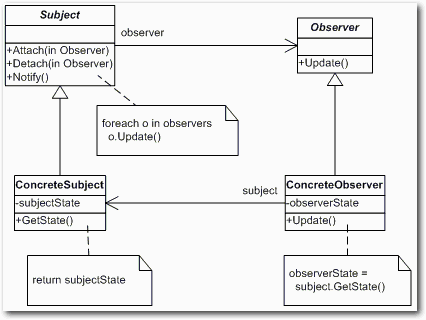javascript设计模式-观察者模式
观察者模式定义了一种一对多的关系,让多个观察者对象同时监听某一个主题对象,这个对象的状态发生变化时就会通知所有的观察者对象,使得它们能够自动更新自己。
UML示意图:

其中的角色:
Subject:主题角色把所有对观察考对象保存在一个对象里,每个主题都可以有任何数量的观察者。主题可以增加和删除观察者对象。并提供订阅和解除订阅的方法。
Observer:在得到主题的通知时更新自己。
例子:杂志订阅
主题角色包含一些对象和方法:
其中subscribers是按照每个类型创建一个数组来存储对应订阅者的一个对象,subscribe()是将对应订阅者添加到相应类型事件的订阅者数组中的方法。unsubscribe()删除订阅者,publish()遍历subscribers中的每个元素,调用他们注册时所提供的方法,type指的是事件的类型,比如出日刊和出月刊。
var publisher = { subscribers:{ any:[] //type of event : subscribers }, subscribe:function(fn,type){ type = type ||"any"; if(typeof this.subscribers[type] ==="undefined"){ this.subscribers[type] = []; } this.subsribers[type].push(fn); }, unsubscribe:function(fn,type){ this.visitSubscribers("unsubscribe",fn,type); }, publish:function(publication,type){ this.visitSubscribers("publish",publication,type); }, visitSubscribers:function(function,arg,type){ var pubtype = type || "any", subscribers = this.subscribers[pubtype], i, max = subscribers.length; for(i=0 ; i<max ; i++){ if(action ==="publish"){ subscribers[i](arg); }else{ if(subscribers[i] === arg){ subscribers.splice(i,1); } } } } };
下面的函数接受一个对象,通过把上述发布者的方法复制到该对象,将其转化为一个发布者:
function makePublisher(o){ var i; for(i in publisher){ if(publisher.hasOwnProperty(i)&&typeof[i] ==="function"){ o[i]=publisher[i]; } } o.subscribers={any:[]}; }
paper对象,发布日报和月刊:
var paper={ daily:function(){ this.publish("big news today"); }, monthly:function(){ this.publish("interesting things","monthly"); } };
将paper构造成发行者:
makePublisher(paper);
订阅者joe:
var joe = { drinkCoffee:function(paper){ console.log("Just read"+paper); }, sundayPreNap:function(monthly){ console.log("About to fall asleep to read this"+monthly); } };
订阅:
paper.subscribe(joe.drinkCoffee);
paper.subscribe(joe.sundayPreNap,"monthly");
触发一些事件:
paper.daily();
paper.daily();
paper.daily();
paper.monthly();
输出:
Just read big news today Just read big news today Just read big news today About to fall asleep reading this interesting things
这样分离的好处,是paper对象与joe对象是可以改动的,可以添加事件类型,可以添加订阅者的行为。甚至joe也可以成为发布者,在Twitter上发布状态更新:
makePublisher(joe); joe.tweet = function(msg){ this.publish(msg); };
paper可以收听joe的Twitter,订阅joe的信息,需要提供方法readTweets:
paper.readTweets = function(tweet){ console.log("Call big meeting!Someone"+tweet); }; joe.subscribe(paper.readTweets);
现在,只要joe发出tweet消息,paper就会得到提醒:
joe.tweet("hated the paper today");
会输出:
"Call big meeting!Someone hated the paper today"
观察者的使用场合是:当一个对象的改变需要同时改变其它对象,并且它不知道具体有多少对象需要改变的时候,就应该考虑使用观察者模式。
观察者模式所做的工作就是在解耦,让耦合的双方都依赖于抽象,而不是依赖于具体。从而使得各自的变化都不会影响到另一边的变化。